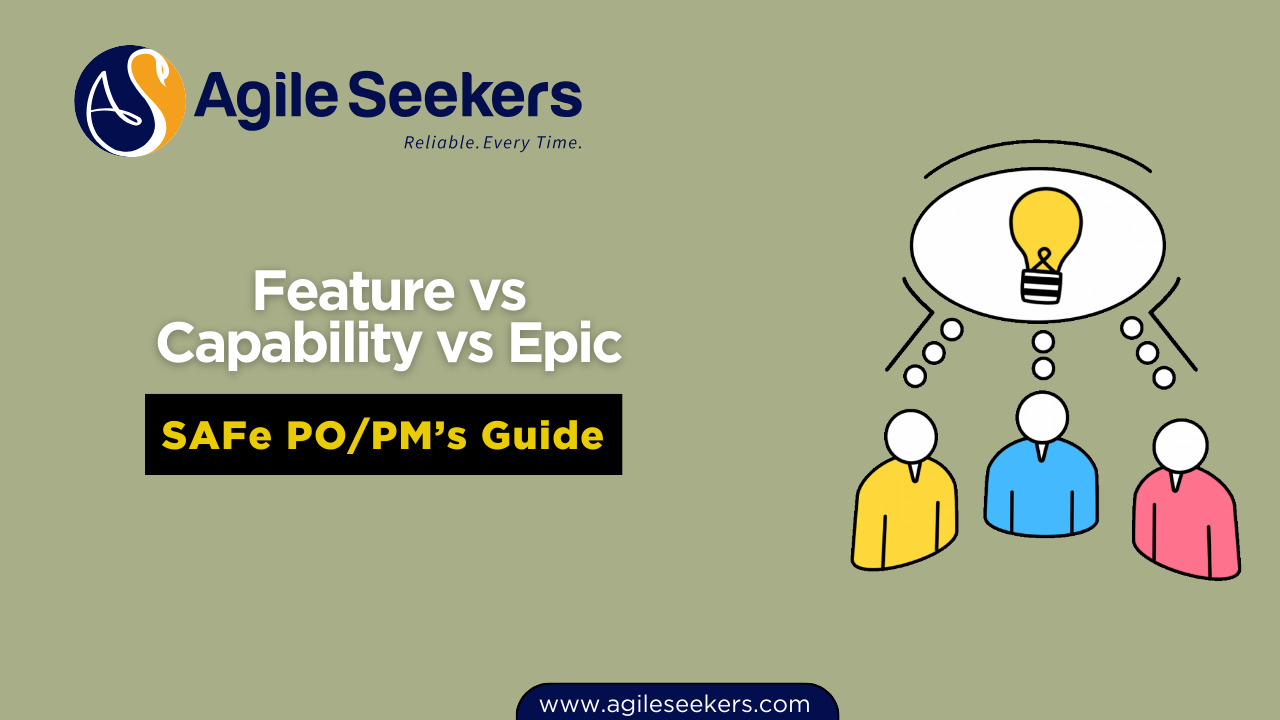Feature vs Capability vs Epic: A SAFe PO/PM’s Guide

In the Scaled Agile Framework (SAFe), managing work across multiple teams and value streams demands a shared language, structure, and hierarchy. For SAFe Product Owners and Product Managers (POPMs), understanding the distinctions between Features, Capabilities, and Epics is essential to drive alignment, prioritize value delivery, and ensure seamless execution.
This guide will demystify these key SAFe work items through clear definitions, real-world examples, and actionable insights—making it a must-read SAFe Product Owner guide for Feature vs Capability vs Epic.
Why This Matters to SAFe POPMs
If you’re on your journey through the SAFe POPM Certification, you already know that SAFe operates at multiple levels: Team, Program, Large Solution, and Portfolio. Each level deals with different types of work items. Knowing what to write, when to escalate, and how to structure these items isn’t just theory—it’s part of your day-to-day responsibilities.
When Product Owners and Product Managers get this right, the results are felt across the ART (Agile Release Train)—more focus, less rework, and faster time-to-market.
The SAFe Work Item Hierarchy
To understand how SAFe work items fit together, think of them as building blocks in a pyramid:
- Epics (Portfolio level)
- Capabilities (Large Solution level)
- Features (Program level)
- Stories (Team level—not the focus of this post)
What Is an Epic in SAFe?
Definition: An Epic in SAFe is a large initiative that typically spans multiple Program Increments (PIs) and requires investment analysis before implementation. It represents a major change or new direction that delivers significant business value.
Types:
- Business Epics: Directly deliver customer value.
- Enabler Epics: Support architecture, infrastructure, or compliance needs.
Example: A telecom company wants to launch a new subscription model with tiered pricing, family sharing, and loyalty rewards. This effort touches multiple systems (billing, CRM, mobile app) and business units. This is a Business Epic.
Key Traits:
- Span several Agile Release Trains (ARTs)
- Require approval through the Portfolio Kanban
- Measured with Lean Business Cases and Weighted Shortest Job First (WSJF)
📘 Learn more about SAFe Portfolio Epics
What Is a Capability?
Definition: A Capability is a higher-level solution behavior that spans multiple ARTs. It’s used in SAFe’s Large Solution configuration, where multiple ARTs coordinate to deliver large systems (e.g., in aerospace, defense, or large-scale enterprise platforms).
Example: Within the subscription Epic mentioned earlier, there’s a need for a "Cross-channel Customer Experience Engine"—a system that synchronizes customer interaction across mobile, web, and in-store. That’s a Capability.
Key Traits:
- Fit within a single Program Increment
- Decompose into multiple Features
- Aligned with Solution Train Backlogs
📘 See how Capabilities work in Large Solution SAFe
What Is a Feature?
Definition: A Feature is a service or function that delivers value to the end user. It’s sized to be delivered within a single PI and is the main currency of value at the Program level.
Example: From the Capability above, a Feature could be “Enable Loyalty Rewards Integration in Mobile App.” It focuses on a single, user-facing function that can be delivered in weeks—not months.
Key Traits:
- Fits within one PI (typically 2-3 Sprints)
- Written using the Benefit Hypothesis + Acceptance Criteria format
- Lives in the Program Backlog
👉 Enroll in the SAFe Product Owner/Manager certification to gain hands-on experience crafting Features that matter.
📘 Understand how Features differ from Stories
Comparison Table: Feature vs Capability vs Epic
| Criteria | Epic | Capability | Feature |
|---|---|---|---|
| SAFe Level | Portfolio | Large Solution | Program |
| Size | Very large (months) | Large (multiple teams, 1 PI) | Medium (1 team/PI) |
| Approval Needed | Yes (via Portfolio Kanban) | Sometimes (Solution Train backlog) | No (comes from Capability/Epic) |
| Example | New pricing model | Unified customer experience | Loyalty rewards in mobile app |
| Measured By | Lean Business Case, WSJF | Solution KPIs | Acceptance Criteria, ROI |
How POPMs Use These Work Items in Practice
Imagine you’re a newly certified SAFe Product Owner embedded in an Agile Release Train for a banking app. You’ve received a directive from leadership: “Improve customer retention through personalized experiences.”
- Epic Stage: The strategic theme is framed as an Epic titled “Enhance Customer Retention through Personalization.” It’s approved in the Portfolio Kanban after economic analysis.
- Capability Stage (if applicable): A Capability might be “Unified Customer Profile System” across digital and branch systems.
- Feature Stage: You, as the Product Manager or Owner, write Features like:
- “Enable Personalized Credit Card Offers in App”
- “Show Transaction Summaries by Spending Category”
Common Mistakes to Avoid
- Don’t write Features as Epics. If it takes 6 months and 4 teams to deliver, it’s likely an Epic or Capability.
- Don’t micromanage Capabilities. Leave the decomposition into Features and Stories to the ARTs and teams.
- Avoid vague language. Features should always include clear acceptance criteria and a measurable benefit hypothesis.
Final Thoughts: Mastering the Flow
Understanding the distinctions between Feature, Capability, and Epic is more than academic—it’s what allows POPMs to act as true value stewards. These work items structure the way ideas flow from strategy to execution.
By mastering this hierarchy, you empower teams, align with leadership, and make measurable impacts.
If you're serious about elevating your role, explore our SAFe POPM training to gain practical insights into backlog refinement, PI planning, and value stream mapping.
Related Resources:
- ✅ What is SAFe Scrum Master Certification? A Beginner’s Guide
- ✅ How SAFe POPM Certification Can Boost Your Agile Career
- ✅ SAFe POPM Certification Cost in India (2025 Update)
Ready to take the next step in your agile career?
Get certified and make a real difference in your organization with our SAFe Product Owner Certification.




















